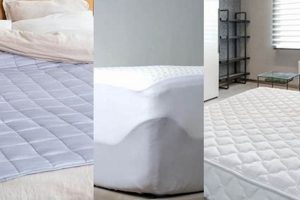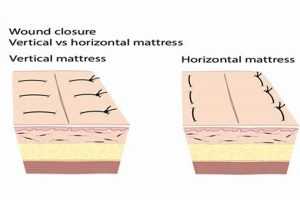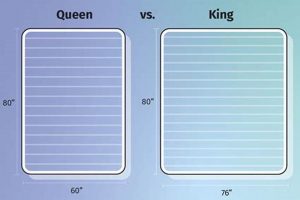The selection of appropriate sleeping arrangements constitutes a key consideration when preparing for outdoor excursions. Two prominent options for elevated comfort are inflatable sleeping pads and framed sleeping platforms. These represent divergent approaches to providing a supportive and insulated sleeping surface within the variable environment of a campsite.
The choice between these two systems significantly impacts several aspects of the camping experience. Comfort level, portability, ease of setup, insulation properties, and durability all differ substantially between these choices. Understanding these distinctions allows campers to optimize their gear selection based on individual needs, trip characteristics, and personal preferences. The historical context of each option reflects evolving technologies and shifting priorities in outdoor recreation.
A detailed examination of the attributes of both inflatable sleeping pads and framed sleeping platforms, including their respective advantages and disadvantages, is presented below. This comparison will facilitate informed decision-making and enhance the overall quality of outdoor rest and recovery.
Optimizing Sleeping Comfort in the Outdoors
Selecting the optimal sleep system significantly influences the overall quality of a camping experience. Considerations must extend beyond simple comfort to encompass factors such as insulation, portability, and environmental conditions.
Tip 1: Assess Environmental Conditions: Before deciding, evaluate the expected temperature and terrain. In colder climates, prioritize insulation; a framed sleeping platform may require additional padding. On uneven ground, an inflatable sleeping pad might conform better.
Tip 2: Prioritize Portability: Weight and packed size are crucial for backpacking. Inflatable sleeping pads generally offer superior portability compared to the bulkier and heavier framed sleeping platforms.
Tip 3: Evaluate Setup Complexity: Consider the ease and speed of setup, particularly when arriving at a campsite late. Inflatable sleeping pads often require inflation, while framed sleeping platforms may involve assembly.
Tip 4: Consider Durability: Evaluate the materials and construction quality. Framed sleeping platforms might offer greater long-term durability, whereas inflatable sleeping pads are susceptible to punctures.
Tip 5: Manage Moisture: Implement strategies to mitigate moisture accumulation beneath the sleep system. This may involve using a vapor barrier or selecting a framed sleeping platform to promote airflow.
Tip 6: Optimize for Comfort: Test different sleeping pad thicknesses and frame designs to find the most comfortable option. Personal preference plays a significant role in this determination.
Tip 7: Budget Accordingly: Establish a budget and compare prices. Inflatable sleeping pads and framed sleeping platforms vary widely in cost, depending on features and brand.
Careful consideration of environmental factors, portability needs, setup requirements, durability expectations, and comfort preferences ultimately leads to a more restful and enjoyable outdoor experience. Balancing these factors contributes to a well-informed decision.
The following sections will delve deeper into the specific features and applications of each sleeping system, providing further guidance for making the most suitable selection.
1. Support
The element of support is a critical differentiator between inflatable sleeping pads and framed sleeping platforms. Support dictates the degree to which the sleeping surface conforms to the body’s contours, evenly distributing pressure and minimizing stress on specific pressure points. Inadequate support can lead to discomfort, restless sleep, and potential musculoskeletal issues during multi-day camping expeditions. An inflatable sleeping pad achieves support through air pressure, adjustable to varying degrees of firmness. A framed sleeping platform provides support via a taut fabric surface stretched across a frame, offering a more consistent, albeit less customizable, level of support. Consider the example of an individual with chronic back pain; the ability to fine-tune the firmness of an inflatable sleeping pad can provide a more tailored support system, potentially mitigating discomfort compared to the fixed support of a framed sleeping platform.
The type of support offered also influences spinal alignment during sleep. A supportive sleeping surface maintains the natural curvature of the spine, reducing strain and promoting relaxation. Inflatable sleeping pads, when properly inflated, can effectively cradle the body and maintain spinal alignment. Framed sleeping platforms, with their more rigid structure, might not conform as closely to individual body shapes, potentially leading to suboptimal spinal positioning. Practical applications of this understanding include advising campers to select an inflatable sleeping pad with baffles or internal structures that minimize motion transfer and enhance support, particularly for individuals sharing a sleeping space. Conversely, those requiring a very firm surface may prefer a tightly stretched fabric cot.
Ultimately, the ideal level of support is subjective and depends on individual preferences, sleeping habits, and physical needs. However, understanding the mechanics of support inherent in both inflatable sleeping pads and framed sleeping platforms enables informed decision-making. Ignoring the critical role of support can negatively impact sleep quality and overall camping experience. Therefore, careful consideration of this factor is paramount when selecting a sleep system for outdoor environments.
2. Portability
Portability represents a core differentiating factor when evaluating inflatable sleeping pads against framed sleeping platforms. The inherent nature of each design dictates significant variations in weight and packed volume, directly impacting suitability for different camping scenarios. The portability consideration is especially acute for backpackers and those engaged in activities where minimizing load burden is paramount. A framed sleeping platform, constructed of metal or rigid composite materials and featuring a stretched fabric surface, typically exhibits a considerably larger packed size and a greater overall weight than an inflatable sleeping pad. This increased bulk necessitates more space within a backpack or vehicle and can substantially contribute to physical fatigue during transport. Consider, for instance, a multi-day hiking expedition where every ounce counts; the cumbersome nature of a framed sleeping platform might render it impractical, compelling the selection of a lighter and more compact inflatable option.
Conversely, the inflatable sleeping pad, designed to compress into a relatively small package when deflated, offers a distinct advantage in terms of portability. Its reduced weight and minimized volume allow for efficient integration into backpacking setups, leaving space for other essential gear. The cause-and-effect relationship is straightforward: reduced weight equates to decreased physical strain during transport and increased agility on the trail. The availability of ultralight inflatable options further amplifies this benefit. However, it is important to acknowledge that the portability advantage of inflatable sleeping pads can be offset by the requirement for an inflation device, which adds its own weight and bulk, though this is generally minimal with modern hand pumps or integrated inflation systems. A practical application involves selecting an inflatable with a self-inflating mechanism, balancing ease of use with optimized packed size.
In summary, the portability of a sleep system is intimately linked to the type of camping pursued. While framed sleeping platforms offer elevated sleeping surfaces and structural stability, their diminished portability restricts their applicability to scenarios where transportation limitations are less stringent, such as car camping. Inflatable sleeping pads, by virtue of their compact and lightweight design, excel in situations demanding maximum portability, enabling a comfortable sleeping experience without significantly compromising pack weight or space. Therefore, a thorough assessment of transportation constraints is essential when selecting between these two options.
3. Insulation
Thermal insulation is a critical consideration when selecting a sleep system for camping. The ability of a sleeping surface to impede heat loss to the surrounding environment directly impacts comfort and safety, especially in cold weather conditions. The intrinsic properties of inflatable sleeping pads and framed sleeping platforms dictate their relative effectiveness in providing insulation.
- Air as a Conductor
Air, in and of itself, is a relatively poor conductor of heat. However, air within a large, uninsulated air mattress can circulate, facilitating convective heat loss from the occupant to the cold ground. This effect can be pronounced, drawing heat away from the body and creating a chilling sensation, even when ambient air temperatures are moderate. This necessitates the use of additional insulating layers beneath the sleeping bag to mitigate heat transfer.
- R-Value and Insulation Materials
Inflatable sleeping pads often incorporate insulating materials, such as down or synthetic fills, to increase their R-value a measure of thermal resistance. Higher R-values indicate greater insulating capacity. The presence and type of fill significantly influence the pad’s ability to retain heat. Framed sleeping platforms, lacking inherent insulation, rely entirely on the insulating properties of the sleeping bag and any additional padding placed on top of the cot. The selection of appropriate insulating materials is paramount to maintaining thermal comfort.
- Ground Contact and Conduction
Direct contact with the cold ground facilitates conductive heat loss. Inflatable sleeping pads, even with insulation, are in direct contact with the ground and can therefore be subject to this effect. Framed sleeping platforms, by elevating the sleeper above the ground, reduce conductive heat loss. This elevation creates an air gap that acts as a thermal break, minimizing heat transfer to the colder ground surface. The magnitude of this effect is contingent on the ground temperature and the airflow beneath the cot.
- Moisture Management
Moisture accumulation, whether from condensation or external sources, can significantly degrade the insulating properties of both inflatable sleeping pads and sleeping bags. Damp insulation loses its loft and ability to trap warm air. Framed sleeping platforms, by promoting airflow beneath the sleeping surface, can aid in moisture evaporation and reduce the risk of insulation degradation. Proper moisture management strategies, such as using a vapor barrier liner, are essential to maintaining optimal thermal performance in either system.
The interplay between these factors dictates the overall insulation performance of inflatable sleeping pads and framed sleeping platforms. While inflatable sleeping pads can offer good insulation with appropriate fill and R-value, their direct ground contact can increase conductive heat loss. Framed sleeping platforms, while lacking inherent insulation, minimize conductive heat loss through elevation and promote airflow, contributing to a drier and potentially warmer sleeping environment. The choice between these systems should be informed by the expected environmental conditions and the user’s individual tolerance to cold.
4. Durability
Durability represents a crucial factor when deciding between inflatable sleeping pads and framed sleeping platforms for camping. The longevity and resistance to damage of each option directly influence its cost-effectiveness and suitability for various camping conditions. The inherent construction and materials determine the lifespan and resilience of these sleep systems.
Inflatable sleeping pads are susceptible to punctures, tears, and valve failures. Sharp objects, rough ground surfaces, and over-inflation can compromise the integrity of the air chamber, leading to deflation and rendering the pad unusable. The frequency of use and the care taken during handling and storage directly impact the lifespan of an inflatable sleeping pad. Framed sleeping platforms, conversely, are generally more resistant to punctures and tears due to their robust construction. The metal or composite frame provides a stable and protective structure, while the tightly stretched fabric is less vulnerable to damage from sharp objects. However, the frame itself can be subject to bending, breakage, or corrosion, particularly under heavy loads or in harsh environmental conditions. A practical example involves a prolonged camping trip in a rocky terrain; an inflatable sleeping pad may require frequent repairs, while a well-constructed cot could withstand the rigors of the environment without significant damage. A cost-benefit analysis would have to factor in repair kits and preventive actions for the inflatable pad to extend usage.
The relative durability of inflatable sleeping pads and framed sleeping platforms is a trade-off between weight, packability, and convenience. Inflatable sleeping pads are typically lighter and more compact, but require greater care to prevent damage. Framed sleeping platforms are more durable but heavier and bulkier. The selection of one over the other depends on the intended use, the environmental conditions, and the user’s priorities. Evaluating expected use conditions and selecting the most appropriate materials based on risk versus utility is a sensible approach. Ignoring durability considerations can lead to equipment failure, discomfort, and potentially hazardous situations during outdoor expeditions.
5. Setup Ease
The ease with which a sleep system can be deployed and prepared for use constitutes a significant factor in the selection process, especially when considering inflatable sleeping pads versus framed sleeping platforms. Setup ease directly impacts the time and effort required at the campsite, influencing the overall convenience and enjoyment of the outdoor experience.
- Inflation Method and Time
Inflatable sleeping pads require inflation, a process that can be accomplished through various methods, including manual pumps, electric pumps, or self-inflation mechanisms. The time required for inflation varies depending on the pad size, inflation method, and individual effort. Manual inflation can be physically demanding, while electric pumps require a power source. Self-inflating pads expedite the process but may still necessitate supplemental inflation for optimal firmness. Framed sleeping platforms, in contrast, typically involve unfolding and locking the frame components, followed by securing the fabric sleeping surface. This process generally requires less physical exertion and can be completed more quickly than inflating a sleeping pad, especially larger models. A camper arriving at dusk after a long trek will find the quicker setup of a cot more appealing.
- Component Complexity and Assembly
Inflatable sleeping pads consist of a single, integrated unit, minimizing the complexity of setup. The only required step is inflation. Framed sleeping platforms, however, often involve multiple components that must be assembled in a specific order. The complexity of the assembly process varies depending on the cot design, but it typically requires some degree of familiarity with the components and their interconnections. Misalignment or improper assembly can compromise the stability and safety of the cot. Therefore, assessing the number and complexity of the components is a consideration.
- Environmental Considerations and Setup Space
The environmental conditions at the campsite can influence the ease of setup for both inflatable sleeping pads and framed sleeping platforms. Uneven ground surfaces can make it difficult to achieve a level sleeping surface with either system. However, the rigid structure of a cot may be less adaptable to uneven terrain compared to the more flexible inflatable pad. Furthermore, the physical footprint of a cot is larger than that of a deflated inflatable sleeping pad and may require more open space for setup. Tight spaces can pose challenges to the easy setup.
- Storage and Packing After Use
Setup ease is inextricably linked to the ease with which a product can be packed back for storage. Air mattresses require deflation and folding or rolling, which can be time-consuming, especially if the valve system is inefficient. The entire mattress must often be compressed to exclude as much air as possible, before it can be returned to its storage bag. In contrast, framed cots typically require disassembly, folding of the frame, and packing of the fabric surface separately. This process can be cumbersome, but is typically faster than fully deflating and packing an air mattress, and cots generally require more storage space.
In summary, setup ease represents a key consideration when selecting between inflatable sleeping pads and framed sleeping platforms. While inflatable pads offer simplicity in terms of component complexity, the inflation process can be time-consuming and physically demanding. Framed sleeping platforms, while requiring more assembly, can often be deployed more quickly and with less exertion. The optimal choice depends on individual preferences, physical capabilities, and the specific conditions of the camping environment. A thoughtful evaluation of the above mentioned elements ensures a smooth and hassle-free setup experience, contributing to a more relaxed and enjoyable outdoor adventure.
6. Cost
The financial investment required for both inflatable sleeping pads and framed sleeping platforms constitutes a significant decision-making factor. Initial purchase price, long-term maintenance expenses, and potential replacement costs must be considered. The economic implications directly influence accessibility and impact the overall value proposition for each sleep system. Variations in material quality, construction techniques, brand reputation, and included features contribute to the price discrepancies observed in the market. For example, a basic inflatable sleeping pad may represent a lower initial investment compared to a high-end framed cot with advanced features such as integrated side tables or adjustable legs. However, the long-term cost equation may shift if the inflatable pad requires frequent repairs or replacements due to punctures or valve failures, events less probable with a sturdier cot.
Furthermore, the cost considerations extend beyond the primary sleep surface. Accessories such as pumps for inflatable pads, ground tarps to protect against abrasion, and storage bags for both options must be factored into the total expense. The need for additional insulation, particularly in cold weather conditions, can also add to the overall cost, as campers may require thicker sleeping bags or supplemental blankets to compensate for the thermal deficiencies of either system. The correlation between price and product durability also warrants scrutiny. Cheaper options may offer attractive upfront savings but often compromise on material quality and construction standards, leading to premature wear and increased replacement frequency. This cyclical pattern of low-cost purchases and frequent replacements can ultimately prove more expensive than investing in a higher-quality, more durable option from the outset.
In conclusion, the cost analysis of inflatable sleeping pads and framed sleeping platforms necessitates a holistic approach that considers both initial purchase price and long-term expenses. While budget constraints often play a significant role in the decision-making process, prioritizing durability, reliability, and user satisfaction can ultimately lead to a more cost-effective and enjoyable camping experience. A thorough assessment of individual needs, camping frequency, and potential maintenance requirements is essential to making an informed investment that aligns with long-term value and financial prudence. This understanding minimizes financial surprises and maximizes the overall return on investment in a camping sleep system.
Frequently Asked Questions
This section addresses common inquiries regarding the selection and use of inflatable sleeping pads and framed sleeping platforms for camping. Clear and concise answers provide guidance for making informed decisions based on individual needs and camping conditions.
Question 1: What factors dictate the choice between an inflatable sleeping pad and a framed sleeping platform for cold-weather camping?
The primary consideration for cold-weather camping revolves around insulation. Inflatable sleeping pads require a high R-value to minimize heat loss to the ground. Framed sleeping platforms, while lacking inherent insulation, elevate the sleeper above the cold ground, reducing conductive heat loss. Supplemental insulation, such as a closed-cell foam pad, may be necessary with either system in extreme cold.
Question 2: How does body weight influence the performance and durability of inflatable sleeping pads and framed sleeping platforms?
Excessive body weight can overstress inflatable sleeping pads, leading to premature wear and potential punctures. Weight limits specified by the manufacturer should be carefully observed. Similarly, framed sleeping platforms have weight capacity restrictions; exceeding these limits can compromise the structural integrity of the frame and fabric. Reinforcements may be needed.
Question 3: What measures can be taken to prevent moisture accumulation beneath a sleeping system during prolonged camping trips?
Moisture accumulation can degrade the insulation and comfort of any sleep system. A vapor barrier liner, placed between the sleeping bag and the sleeping surface, minimizes moisture transfer. Framed sleeping platforms promote airflow beneath the sleeping surface, aiding in moisture evaporation. Regular airing out of both the sleeping bag and the sleeping surface is also recommended.
Question 4: How does the type of terrain influence the suitability of inflatable sleeping pads versus framed sleeping platforms?
Inflatable sleeping pads are more adaptable to uneven terrain, conforming to ground contours and providing a more level sleeping surface. Framed sleeping platforms require relatively flat ground for stable setup. Rocky or sloping terrain can compromise the stability of a cot and create pressure points.
Question 5: What are the recommended repair procedures for punctures in inflatable sleeping pads?
Prompt repair of punctures is essential to maintaining the functionality of inflatable sleeping pads. Repair kits typically include adhesive patches and instructions for application. The damaged area should be cleaned and dried thoroughly before applying the patch. Self-adhesive patches offer convenient field repairs, while more robust adhesives provide a more permanent solution.
Question 6: How does the packed size of each option impact suitability for different camping styles?
Inflatable sleeping pads generally offer a more compact packed size, making them ideal for backpacking and situations where minimizing weight and volume is critical. Framed sleeping platforms are bulkier and require more storage space, limiting their suitability for backpacking. Car camping scenarios, where transportation constraints are less stringent, are more conducive to the use of framed cots.
In summary, the selection of the optimal sleep system involves a careful consideration of individual needs, environmental factors, and logistical constraints. The answers provided herein offer guidance for making informed decisions and maximizing comfort during outdoor excursions.
The concluding section will summarize key points and provide final recommendations for selecting the most appropriate sleep system for your camping needs.
Concluding Summary
The preceding analysis has explored the critical considerations surrounding the selection of appropriate sleep systems for camping. Inflatable sleeping pads and framed sleeping platforms present distinct advantages and disadvantages relating to support, portability, insulation, durability, setup ease, and cost. The optimal choice hinges on a thorough evaluation of individual needs, environmental conditions, and logistical constraints. Factors such as body weight, terrain type, and anticipated weather patterns significantly influence the suitability of each option. An informed decision necessitates a comprehensive understanding of the inherent characteristics and limitations of both sleep systems.
Ultimately, the selection between an inflatable sleeping pad and a framed sleeping platform represents a balance between comfort, convenience, and practicality. Campers are encouraged to carefully weigh the aforementioned factors to make a decision that aligns with their specific requirements and preferences. Prioritizing a well-informed choice promotes safety, comfort, and enjoyment during outdoor activities, contributing to a more positive and sustainable engagement with the natural environment.







